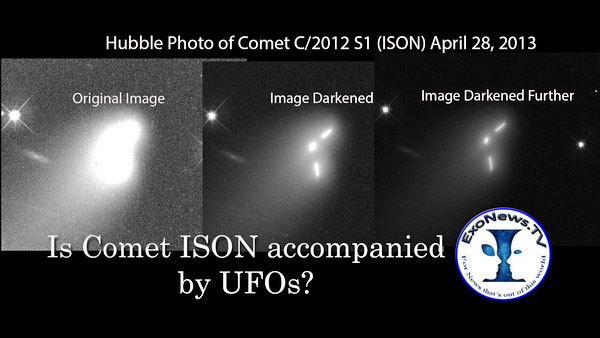|
from
Examiner Website
The latest news reports reveal Comet C/2012 S1 (ISON) is brightening and may yet become the comet of the century.
But is ISON a comet?
A startling photo has been circulating of comet C/2012 S1 (ISON) that shows it comprises three objects rather than a solitary nucleus as claimed by NASA astronomers. The photo was taken by the Hubble space telescope on April 30, 2013, and it shows two of the objects are highly symmetrical cylinder shapes.
In August, a number of bloggers began claiming that comet ISON was accompanied by two UFO motherships, and/or its core was in fact a large biosphere. Not so according to NASA scientists who officially responded in a post that the three objects are merely an overlay of three different time exposures of comet ISON.
Comet ISON was discovered in September 2012 by Russian amateur astronomers. It was first photographed by the Hubble Space Telescope on April 10. After disappearing behind the sun from June to August, it appeared again in late August.
According to NASA, the Hubble image shows a conventional comet with a small nucleus and a large coma. NASA estimates the nucleus as between three to four miles across, while its coma is about 3100 miles wide and its tail is 57,000 miles long.
Comet ISON began passing Mars on October 1. It was photographed by NASA's Mars Reconnaissance Orbiter on September 29.
Comet ISON will make its closest approach to the sun on November 28, which is Thanksgiving Day in the USA. On its way back from the sun, Comet ISON makes its closest approach to Earth on December 26, where it will be 40 million miles away. Clearly too far away for doomsday collision theories.
NASA has plotted the trajectory of Comet ISON showing how it passes relatively close to Mars, makes a close flyby of the sun, and then orbits back at some distance from Earth. Many astronomers hope it displays spectacular fireworks as it passes close to the sun in late November. Some going as far as claiming it will the "comet of the century."
Normally, comets heat up and some expand spectacularly as the icy core heats up and gasses ignite. Comet ISON has begun brightening as it approaches the inner solar system.
Alan Pickup from the Guardian newspaper today wrote:
Amateur astronomers have analyzed the Hubble telescope images and found that one of them shows the core of Comet ISON comprises three objects - two of which are highly symmetrical cylinder shaped.
The three objects clearly reveal themselves when the lighting in the photo is turned down. You can test this yourself.
According to the amateur astronomers, NASA could not have failed to have noticed this. It is claimed that NASA is hiding the true composition of Comet ISON with images it has released that show only a solitary nucleus.
Did NASA simply overlook that the comet’s core comprises three objects or is it hiding something? Hubble astronomers claim, however, the April 30 photo of ISON doesn’t show three objects at all.
In an official reply to blogger claims, Hubble astronomers claimed that the photo,
What makes the issue even more mysterious is an alleged video of comet ISON that appears to show the nucleus being circled by two UFOs.
The video is claimed to be from a Chinese satellite, however, the Chinese Space Agency does not contain the video on its website. Furthermore, the resolution is too clear for such a distant object suggesting the video has been forged.
Why would someone go to the trouble to create a fake video of comet ISON comprising two cylindrical UFOs circling a nucleus? Was it to generate confusion over the true composition of comet ISON or to call attention to it being accompanied by UFOs?
Regarding the latter possibility, there are many competing claims.
One 'blogger' (from The Andromeda Council), Tolec, claims that Comet Ison is, in fact, a large biosphere accompanied by two smaller ships:
One thing is clear so far:
Could it be that the image is simply an overlay of three different time exposures as Hubble astronomers suggest? In this scenario favored by NASA, the most we can hope for is that ISON spectacularly expands to become the "comet of the century."
Alternatively, does Comet ISON comprise two UFOs accompanying its nucleus as depicted in the alleged Chinese satellite imagery, or is it a large biosphere accompanied by two escort ships?
We will have to wait for the truth to emerge as Comet ISON makes its closest approach to the sun in November 2013.
|

